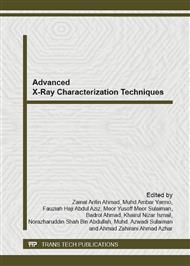p.435
p.440
p.446
p.453
p.458
p.464
p.469
p.474
p.480
Preliminary Evaluation of Mukah Clay Deposits
Abstract:
Mukah clay deposits are characterized and evaluated for their potential as industrial raw materials through chemical, mineralogical and fired body (900 to 1250o C) physical properties determinations. Results show that the main oxides in the samples are SiO2 and Al2O3, whereas the other oxides present only in small quantity. Kaolinite and quartz present as dominant mineral phases and the minor phases of muscovite, nacrite, illite also appeared in the samples. From the results of the fired properties, the significant development of densification of ceramic behaviour can be noticed at the firing temperature above 1000°C. Mukah clay demonstrated that it is most suitable to be used as raw materials for making pottery, general refractory, structural ceramics, wall and floor tiles.
Info:
Periodical:
Pages:
458-463
Citation:
Online since:
December 2012
Authors:
Price:
Сopyright:
© 2013 Trans Tech Publications Ltd. All Rights Reserved
Share:
Citation:


